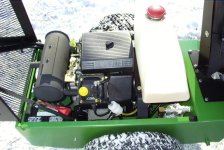BobRip
Elite Member
I agree with Moss. I have been leaving battery tenders on all four of my small engines for many years. I usually replace them at five years, but they still work. Just one man痴 experience.
Yep the tenders do a good job not disagreeing w any of you wise folks... Just saying the hf ones may not be doing it as right as others. I think my neighbors point was some of the cheapo units malfunction... But don't appear to be...consequently shorten battery life. Not saying who but his org definitely counts on you coming to dealer for hand holding and wallet cleaning(a free service).
Carb cleaner is kind of a do all, eh?
I generally get 6 years from a battery unless it had a real hard life (involving keys or lights left on)... The extra time i imagine comes from relatively casual weather conditions here. Minus anything temp related looks like a typo to me.
Sooo many things to say about the PT scar delivery system (exhaust)... It'd just be little ******* stars on the forum though. ;-)
Good luck in the vortex.

I've got nothing to add that hasn't be said already.
I think my 2001 PT425 stock Kohler exhaust was probably the best VS anything I've seen that PT has made themselves. It's stock from the factory. It exits directly out the rear. Nothing sticks out anywhere.
Drawback.... gotta remove it to get to the battery.
View attachment 589381
Just to add a little to the issue with battery chargers/tenders. If the gizmo consistently applies more than 14V per battery, and you leave it hooked up, you can get battery damage (i.e. trickle charging for a long time). This is the issue with trickle chargers. Historically, they were low power, current limited devices (i.e. they could put out a few milliamps), but they had no upper limit on the voltage. Hence the problem. The magic number is north of 14V, depending on internal losses, and cable losses.
Battery minders have microcomputers in them that monitor the the voltage and the current, and don't dumbly apply current or voltage. After the batteries hit full charge, they drastically reduce the charge and voltage, and allow a few percent self discharge, and then fill it up again. This keeps the battery in good health. Some even apply high frequency AC to help reconvert sulfate crystals. Depending on the battery condition, this may or may not restore it to full working order. Sulfation is a bit of a chemical mystery, but the bottom line is it aint good for your battery.
The extreme version of this are lithium ion batteries which have a chip built into the battery pack that constantly computes the power delivered, and cuts out the battery when it is too discharged, and then the charger communicates with the battery to determine the correct voltage/current at each point in the charging cycle. (It is also why you can't throw a brand M battery pack on a brand D charger, as they may not communicate well.)
If you have a vampire in your tractor, that aint good either. Slow leaks are a definite pain to track down. Depending on the size of your leak, the difference between battery tenders and trickle chargers may not make a difference, but these days, the cost of "real" battery minders/chargers is close enough to the trickle chargers, that I think the investment is worth it.
Weather makes a huge difference in battery lifetime; really cold and really hot are problematic. Cold weather calls for all of those CCA, and the current is just plain tough on the chemistry. One night with the lights left on in the cold can kill a battery. Polar vortex starts are like cat lives. You have more than one, but do not count on it. Hot weather makes the non-useful battery chemistry a larger fraction of the battery chemistry, and batteries are more prone to losing water, which alters the chemistry and function.
I hope that this helps.
All the best,
Peter